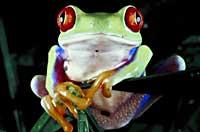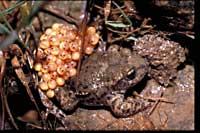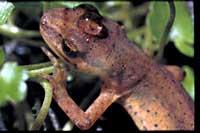Toads only in stories

They say it's happening in most parts of the world: amphibians are increasingly scarce. Frogs from water wells, granular bark toads, mountain tritons... are peculiar beings that seem to be very influenced by human changes.
They have just received data from around the world and have come to a clear conclusion: One-third of amphibian species on earth are endangered. And also, the reasons are not very clear. There are many factors that can influence the extinction of amphibians, but it is possible that many of them are not yet known to humans, although it is considered that the main agent is the human being himself.
No pools, no amphibians
The main cause of amphibian extinction danger may be habitat destruction. In the Basque Country itself, the colonization of amphibious settlements by man stands out. For years the transformation that has occurred in the drying of marshes and other wetlands and in the construction of housing, industrial estates, etc. The habitat of living beings originating in these means has disappeared in many cases.
Having less accommodation, there are fewer and fewer frogs and frogs, and the rest of amphibians have no better state. In wetlands not desiccated by humans still live the most common, harshest species, but the status of special species is more serious; like the frog of trees, other species would be lost if strict protection measures are not adopted.

And the situation of amphibians in Euskal Herria is also a reflection of those around the world. In fact, it is believed that a hundred species of amphibians have disappeared in the world since the 1970s. What is more serious is that many threatened species seem to inhabit rich habitats, away from human influence, such as tropical forests. But experts are unclear why some such abundant species have been reduced.
Endless risks
Starting to look for the causes of amphibian danger, the main factor is habitat destruction, but there are also many others. Keep in mind that amphibians have a very special skin, a kind of mucosa, which is used to breathe. The drying of this skin kills the frog, the triton or whatever. Amphibians are therefore very sensitive to climate change.
Global warming is spoken every day and it is expected that one of the first to notice it is amphibians. If the climate is warmer, the water from the wells is drying up and amphibians have to live in shallow puddles, or at least their larvae and swords, and the riverside vegetation can be reduced. Consequently, they have less protection, especially the ultraviolet radiation coming from the Sun hits them more strongly, which can affect the immune system or growth.

The sensitive skin of amphibians is easily attacked by strong sunlight. And if you consider that many wetlands are contaminated by chemicals... that amphibians have a wonderful future. Thus, outside protected areas, there is not much healthy population. Many of the amphibians that lived in extensive lands are limited to certain wells, so there is a small genetic diversity in these amphibian communities.
And man has also suffered more indirect damage, because when he goes to the place where he goes, he leads some alien species. Many of these species are predatory animals and little benefit the small amphibian family of the place. The nation-death balance is broken in a thousand ways, since human beings carry diseases.
Unfortunately, researchers, despite good faith, have done harm by carrying unknown diseases. The irresponsibility suffered by some species that never had contact with the human being was compensated by the danger of extinction that ran when they discovered new species, many of them very abundant.

Among these diseases, herpetologists (amphibian experts) are most concerned about critical fungal infections. These fungi get into the skin of amphibians and prevent them from breathing. Apparently, other factors, such as global warming and ultraviolet radiation, have facilitated the diffusion of these fungi.
For this reason, experts currently carry out very strict hygienic measures whenever they approach a group of amphibians. Among other things, they use disinfected material, no penetration is performed and a working protocol with amphibians is underway. However, it remains to be seen whether all these measures are sufficient not to further harm amphibians.
Published in 7K.
Buletina
Bidali zure helbide elektronikoa eta jaso asteroko buletina zure sarrera-ontzian











